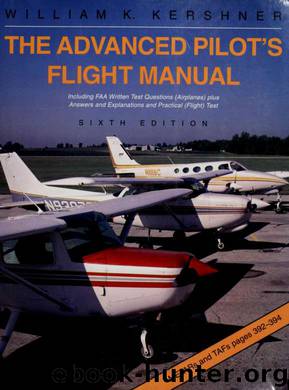The advanced pilot's flight manual : including FAA written test questions (airplanes) plus answers and explanations and practical (flight) test by Kershner William K

Author:Kershner, William K
Language: eng
Format: epub
Tags: Airplanes
Publisher: Ames : Iowa State University Press
Published: 1994-05-14T16:00:00+00:00
RETRACTABLE-GEAR AIRPLANES
175
is made. If you have any idea of icilling the engine at altitude, slowing the plane up until the prop stops, and making it horizontal with the starter, forget it unless the runway is extremely long (say, 10,000 or 12,000 ft). This is no time to be practicing dead stick landings. A bent prop is a small price to pay for assurance that the field is made.
Your POH will cover the procedures lor \arious gear problems, but here's an item you might consider if you have a flat nosewheel lire or the nosewheel remains up (and the main gear is down and locked). At'ler touchdown, as you're holding the nosewheel off as long as possible, if it's not distracting you might roll in nose down trim to help keep the nose up to as slow an airspeed as possible. (Logical reasoning would assume that the elevator-stabilator trim should be rolled to a nof,e-up setting but if you check the positions for nose-up or nose-down trim you'll see that for most airplanes more area is available in the latter condition.)
Summary of Emergency Procedures. (The exact emergency procedures vary, as some airplanes use electrical power for gear actuation and others use hydraulic means.)
1. Take your time and analyze.
2. Know your emergency procedures.
3. Keep the POH handy to help you remember each step.
4. Again, lake your lime.
SOME MORE POINTS ABOUT RETRACTABLE GEAR. Some pilots get Ihc idea thai the sooner ihe\ gel ihe gear up on takeotf the belter they look to the airport crowd. 'Tain't sol
The landing gear has a safety switch (electric gear) or a by-pass valve (hydraulically actuated gear) on one of the oleos to ensure against inadvertent retraction on the ground. As long as the weight is on this gear (the oleo is compressed), the landing gear can't be retracted (oh yeah?). Don't depend on this safety switch —it might not be working that day. Curiosity can cost money, so don't test the antireiraclion safety features.
Even if the safely mechanism is working normally, don't get any ideas of putting the gear handle up during the takeotT run to "look sharp," because a gust might lift the plane enough temporarily to extend the oleo and the gear would start up before you're ready. Don't raise the gear before you are definitely airborne and no longer land gear-down on the runway should the engine quit.
Apply the brakes after takeoff before retracting the gear. Otherwise the wheels will be spinning at a good clip when they enter Ihe wheel wells and can burn rubber that you might
want to use later. Most manufacturers have butfer blocks on strips iti the main wheel wells to slop the spinning, but you might as well save the tires as much as possible. Of course there's nothing you can do about a nosewheel. For larger airplanes with high takeofl" speeds, this braking is frowned upon, as the rapidly spinning heavy wheel has a great deal of inertia and the sudden slopping of the wheel may cause the tire to slip around the rim.
Download
This site does not store any files on its server. We only index and link to content provided by other sites. Please contact the content providers to delete copyright contents if any and email us, we'll remove relevant links or contents immediately.
| Automotive | Engineering |
| Transportation |
Small Unmanned Fixed-wing Aircraft Design by Andrew J. Keane Andras Sobester James P. Scanlan & András Sóbester & James P. Scanlan(32693)
Navigation and Map Reading by K Andrew(4974)
Endurance: Shackleton's Incredible Voyage by Alfred Lansing(4635)
And the Band Played On by Randy Shilts(2091)
The Box by Marc Levinson(1905)
Top 10 Prague (EYEWITNESS TOP 10 TRAVEL GUIDES) by DK(1903)
Wild Ride by Adam Lashinsky(1903)
The Race for Hitler's X-Planes: Britain's 1945 Mission to Capture Secret Luftwaffe Technology by John Christopher(1773)
The One Percenter Encyclopedia by Bill Hayes(1764)
Trans-Siberian Railway by Lonely Planet(1670)
Girls Auto Clinic Glove Box Guide by Patrice Banks(1657)
Looking for a Ship by John McPhee(1611)
Batavia's Graveyard by Mike Dash(1588)
TWA 800 by Jack Cashill(1571)
Fighting Hitler's Jets: The Extraordinary Story of the American Airmen Who Beat the Luftwaffe and Defeated Nazi Germany by Robert F. Dorr(1548)
Good with Words by Patrick Barry(1547)
Troubleshooting and Repair of Diesel Engines by Paul Dempsey(1534)
Bligh by Rob Mundle(1525)
Ticket to Ride by Tom Chesshyre(1524)
